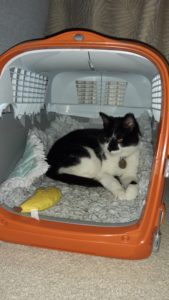Bringing your pet to the vets can be stressful at the best of times but when they don’t like coming it can be even more problematic, not only for the patient but for you as the owner too. Cats can be particularly susceptible to stress (which, as we all know, is a negative emotion) as they rarely leave their home environments or have trips in the car. This article will cover how to make vet visits for your cat less stressful!
As mentioned previously cats rarely have to leave their homes and when they do it usually results in what they may perceive as a negative experience e.g. the cattery or the veterinary practice. Cats can make negative associations with their cat carrier (which they might have to be forced to get in to if they will not go in of their own accord) and the car (which is noisy and the movement is unfamiliar) which then trigger their anxiety even before they get to the veterinary practice.
The Cat Carrier
Making the cat carrier a more positive experience at home will be a good start in lowering stress levels before you embark on your journey. When buying a carrier it is important to think about whether it can be easily taken apart or not. The carrier becomes the most familiar place to the cat in the veterinary environment and so, despite not wanting to get in at home, they often do not want to leave it once they arrive at the surgery! Being able to deconstruct the carrier around your cat prevents any confrontation or stress when trying to remove them from it and allows visualisation and often some examination, in what they now perceive as the safest of the options! Also consider the width of the doorway – this should be as wide as possible to aid entry and exit.
It is sensible to have the carrier visible in the house at all times. If you are able to deconstruct the carrier then the lower half, combined with a suitable bed, can be used as a resting place for your cat. If your cat is very worried about the carrier then just start with the bedding you are planning on using in it. When your cat approaches the bed, you can reward them by throwing a treat onto the bed to try and form a positive association. Once they are comfortable with using the bed, it can be placed into the lower half of the carrier and placed back into the same spot. You may need to reward them again for approaching the bed but eventually they should start to lie on it again. Once reliably performing this step the lid can be placed on top (without the door). Rewards then can be placed through the sides of the carrier and later through the door.
Once used to the carrier, it is useful to take your cat on short car journeys that do not involve going to the cattery or vets. This gets them used to the sensation of travelling in the carrier without any additional stress.
The Waiting Room
Hollybank is a Gold Level Cat Friendly clinic under a scheme run by the ISFM (International Society of Feline Medicine). This means that we have met specific criteria throughout the practice and have taken into consideration the unique needs of cats in how we approach and handle them.
The waiting room can be a place of loud noises, different scents and visual stimulation. If it is particularly noisy when you arrive for your appointment please speak to a receptionist who will find your cat somewhere quieter to wait. Feline pheromone therapy can be sprayed on to the bedding in the carrier 10-15 minutes before you need to put your cat into it (this allows the alcohol carrier to evaporate). This pheromone helps to reassure your cat that they are safe. In our reception area we have a visual barrier between the dog and cat seating areas but we also have carrier covers available from our reception.
Once in the consulting room you may find that your cat does not want to come out of the carrier. Having a carrier that can be deconstructed around them is now beneficial and allows the cat to be examined in the carrier if appropriate, or gently lifted out. If they are removed from the carrier then this should then be put out of sight as they often wish to get back in straight away which can become a source of frustration and therefore increased stress. Once the examination is complete allow them to retreat quickly back to the carrier.
As a practice we understand that patience is essential when handling cats. Our fifteen minute appointments allow plenty of time for your cat to get used to the consulting room environment before being examined.
Implementing these simple changes mentioned above, before your vet visit, will help reduce your cat’s stress levels and combined with our understanding of handling cats this should lead to happier visits to the vets for all!
We will shortly be adding a new ‘Cat Friendly’ section to our website with further details on choosing a suitable carrier, getting your cat used to the carrier and travelling with your cat – as well as tips and advice on how to medicate your cat.
